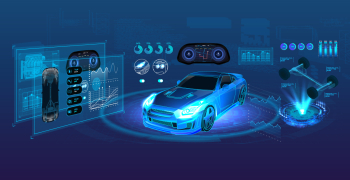Imagine an orchestra. Each instrument plays a unique role – seamlessly blending its notes to create a perfect harmony. At the heart of this mesmerizing performance is the unifying presence of the conductor, ensuring that every musical note is in sync.
Embedded systems operate in a similar manner within the modern industrial and technological landscapes. They are the unseen conductors, orchestrating the interplay of hardware and software, ensuring precision, efficiency, and reliability across myriad applications.
From automotive innovations to healthcare equipment to advanced telecommunications, embedded technologies are the unsung heroes enabling sophisticated performance across industries. Their significance continues to grow as industries push the boundaries of digital transformation, and engineering and technology services play an increasingly critical role in fostering excellence across the domain.
The Backbone of Modern Applications
Embedded systems are specialized computing units that execute specific functions within larger systems. Unlike general-purpose computers, an embedded system is tailored for precision and durability, making them critical for an expansive range of applications. Their footprint spans from the ubiquitous microcontrollers in washing machines to complex avionics systems in large aircraft.
Take the automotive industry, for instance. Embedded systems are the brains behind advanced driver-assistance systems (ADAS), smart infotainment units, and critical safety features like electronic stability control. An autonomous vehicle, equipped with LiDAR and an array of detectors, relies heavily on embedded technologies to process real-time data and make split-second decisions. These systems exhibit unparalleled reliability, given their role in safeguarding lives.
Similarly, in the healthcare industry, embedded systems are the driving force behind life-saving devices like pacemakers, infusion pumps, and diagnostic machines. For example, an MRI scanner integrates embedded technology to precisely analyze imaging data, rendering detailed visuals of a patient's internal physical state. The ability of these systems to operate seamlessly under stringent standards of accuracy and safety underscores their importance.
Key Pillars of Embedded System Excellence
Embedded systems cannot thrive without the spark of innovation provided by sustained engineering and technology excellence. The focus is to go beyond just assembling technologies, concentrating on enhanced value delivery by designing, developing, testing, and refining intricate systems that meet evolving industrial demands. This includes:
- Designing with Precision
Precision in embedded system design serves as the cornerstone for delivering high-performance solutions across diverse applications. Consider the creation of energy optimization systems for smart infrastructures — these systems monitor individual components to maintain balanced performance, ultimately extending the lifespan of critical machinery. Through the use of advanced simulation tools and iterative testing, designers can fine-tune prototypes, reducing errors and boosting operational efficiency prior to real-world implementation.
A similar narrative unfolds in the healthcare sector, where precision engineered portable diagnostic tools leverage embedded systems to process real-time patient data. This capability enables accurate monitoring and timely, informed decision-making. The success of such high-stakes applications is rooted in rigorous design methodologies including model-based development, ensuring that the precise outcomes are uncompromised even in the most demanding scenarios.
- Driving Innovation Across Industries
Embedded systems play a pivotal role in leveraging innovations originally designed for one industry into groundbreaking solutions for others. Take, for example, imaging technologies initially developed for quality inspection in industrial manufacturing. These technologies have been reimagined for healthcare applications, enabling the creation of detailed digital maps of anatomical structures. This cross-industry adaptation not only broadens the potential of these systems but also accelerates their evolution for critical sectors like medicine.
A similar transformation is evident in automation technologies. Systems originally deployed in industrial robotics to optimize manufacturing workflows are now revolutionizing agriculture. Embedded solutions in the domain have driven advancements such as automated harvesting and precision irrigation control, optimizing labor demand while significantly boosting productivity.
- Testing for Robustness
Robustness in embedded systems is key to ensuring reliability and versatility, particularly in demanding environments. For instance, the rigorous testing protocols designed to validate aerospace-control systems prior to deployment are subjected to extreme condition simulations that replicate potential operational challenges, such as thermal fluctuations, vibration, and mechanical stress. Exhaustive testing guarantees resilience and reliability, even in the most high-risk scenarios.
A parallel can be drawn with embedded systems in healthcare equipment, which also undergo stringent validation processes to meet the demands of prolonged use and high precision. For example, durable medical devices are tested through simulations that mimic years of operation across diverse environments, ensuring consistent performance in life-critical applications. By prioritizing robustness, these systems build trust and deliver reliable results under all conditions.
- Addressing Sustainability Considerations
Sustainability is rapidly becoming a cornerstone in embedded system development. Embedded solutions are revolutionizing energy consumption, enabling industries to reduce their environmental footprint. For instance, integrated systems in energy-efficient buildings that intelligently manage climate control, lighting, and other utilities can dynamically adapt to occupancy and environmental conditions, drastically reducing energy wastage
The agricultural sector also benefits from the environmental advantages of embedded systems through precision farming technologies. Integrated sensors and real-time analytics streamline the application of resources, including, water, fertilizers, and pesticides. These solutions minimize unnecessary usage, aligning operational efficiency with long-term environmental objectives.
The Road Ahead
The future will demand an increasing focus on software-defined solutions, adaptive manufacturing, and a unified blending of physical and digital realms. Embedded systems, with their unparalleled precision and versatility, will continue to anchor these transitions.
Rising above their role as silent enablers, embedded systems symbolize the possibilities unlocked when engineering brilliance meets real-world challenges. Just like the conductor of a symphony, play a key role in harmonizing complex operations, empowering industries to stride confidently toward their goals.
The foundation of embedded excellence, therefore, will not just be a technical achievement but rather, a testament to the boundless potential of technology and engineering innovation paradigms.




